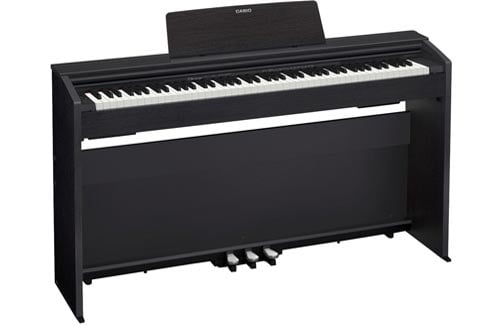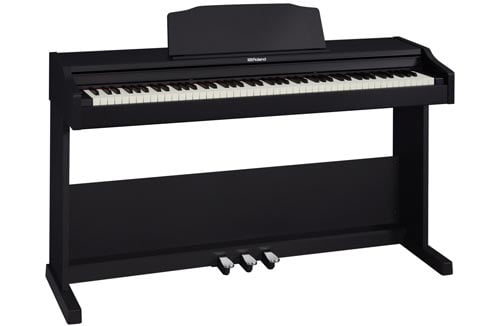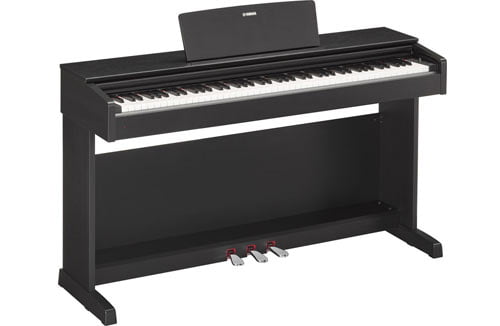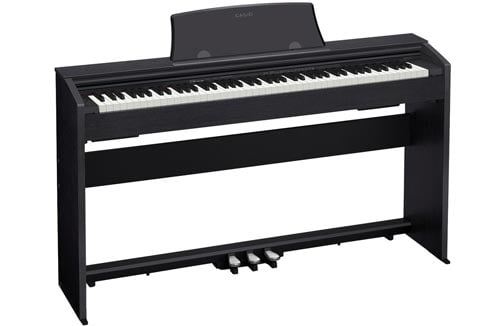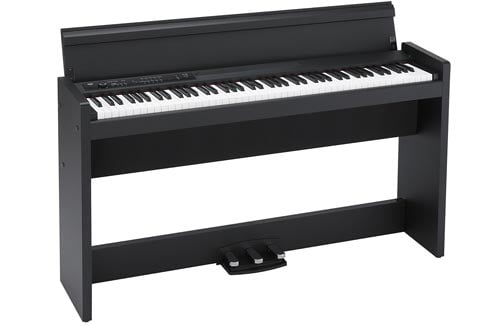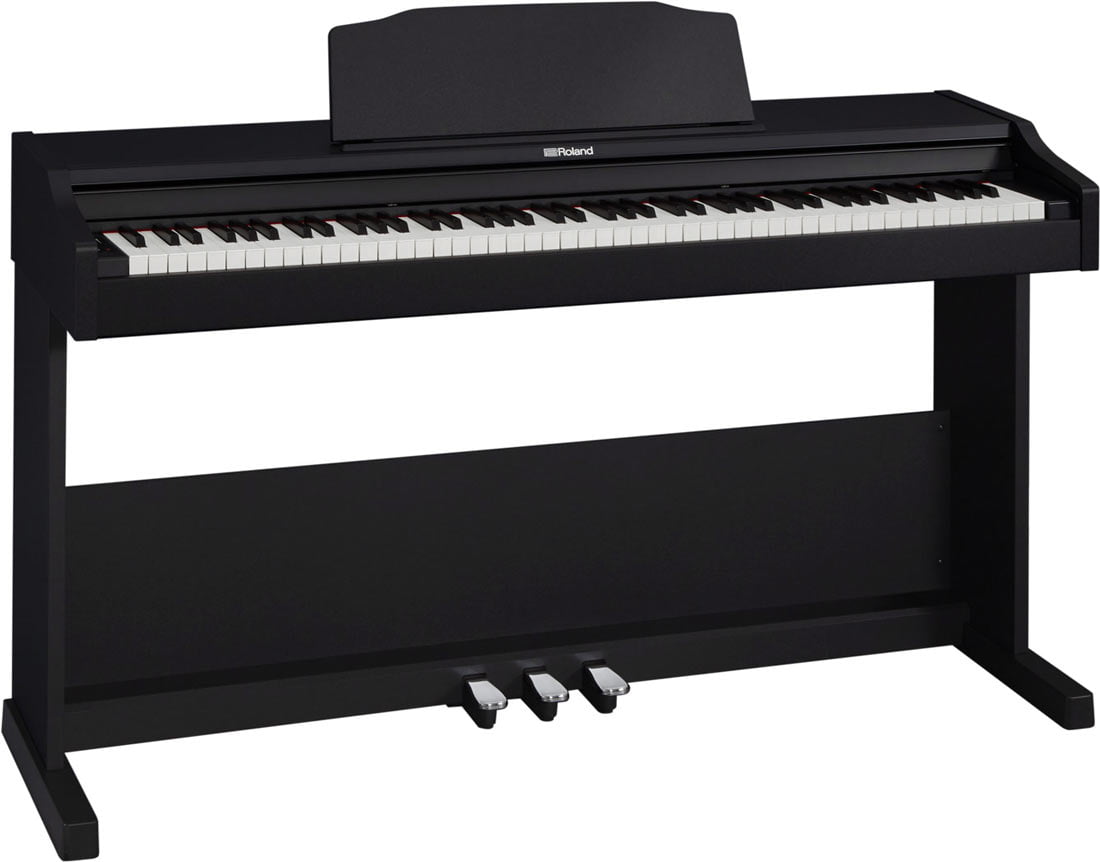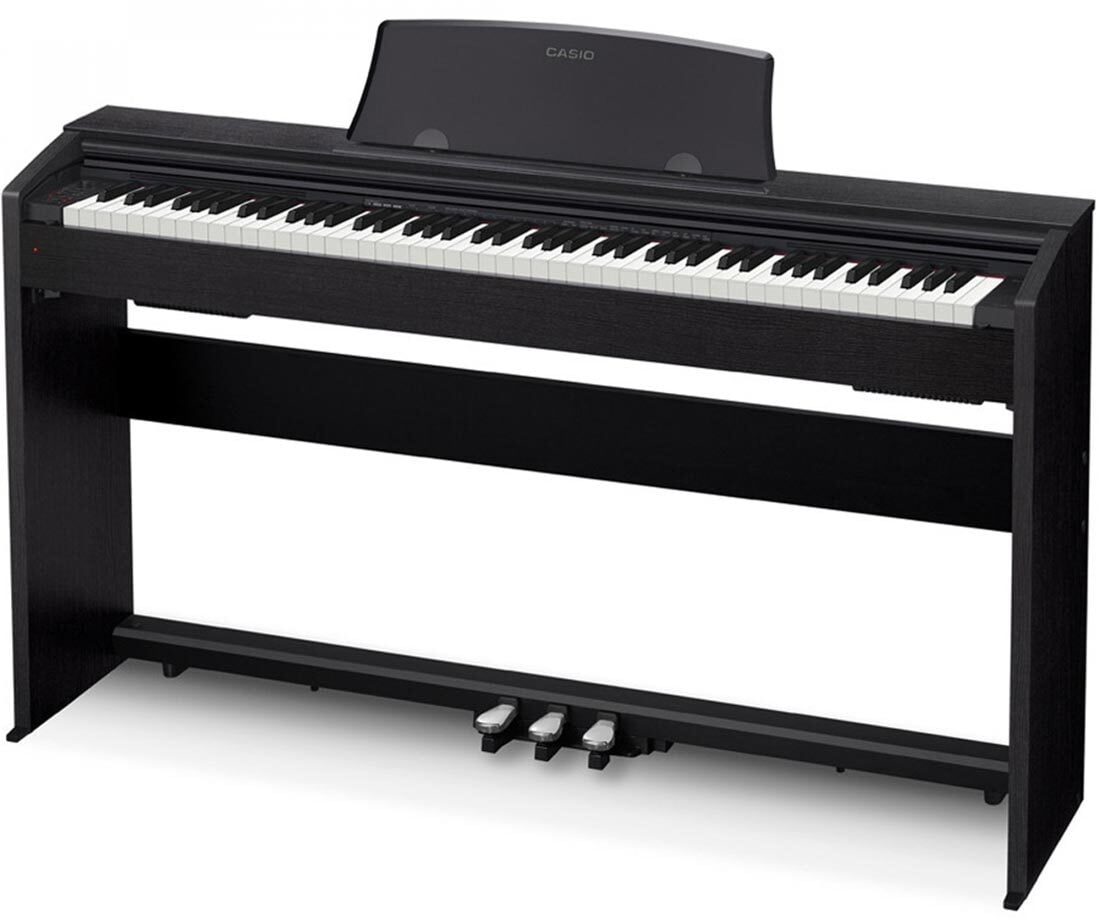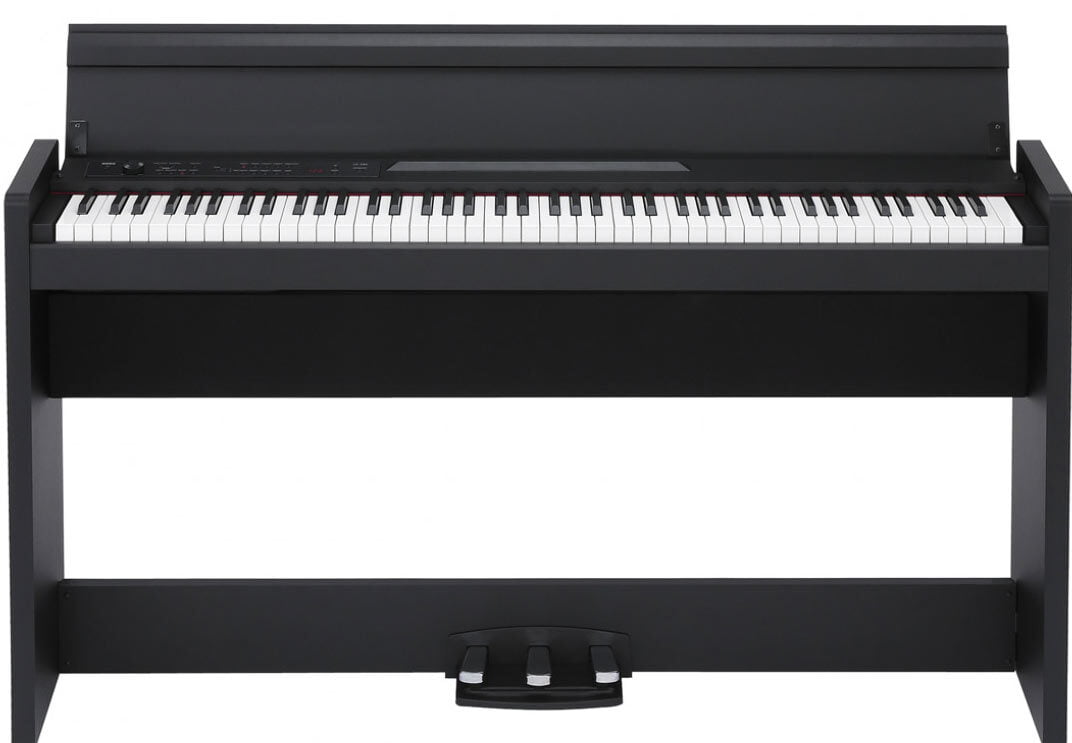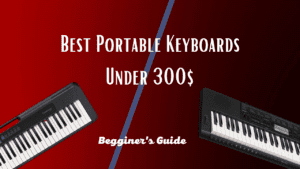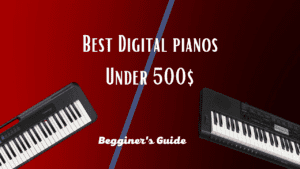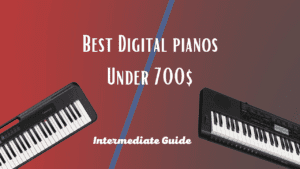Pianos are popular in homes and music. But, getting a good one is pricey. So, modern tech has budget-friendly digital piano options. This guide has info about the best digital piano brands and pianos under $1,000. It has sound quality, features, specs, and user reviews. Whether it’s for practice or performance, this guide has something for you. Let’s get started!
Console digital pianos are a hit with many home studios. They come in a range of prices and styles. Lower-priced models have fewer features and basic sound. On the other hand, higher-end models offer realistic grand piano sounds, weighted keys and more.
For those looking to experience quality instruments at under $1000, Yamaha’s P-45B offers piano sound, 64 note polyphony and 10 voices including electric pianos and organs. Casio’s Privia PX160 has an additional layer of realism.
.jpg)
At the mid-range, Roland’s FP30 has Bluetooth support and headphone connectivity. Kawai’s ES110 has reverb effects and USB ports.
For those looking for high quality console digital pianos priced under $1000, Yamaha Arius YDP141 and Casio AP270 both have 88-note graded hammer action mechanisms, 3 pedals and multiple effects. These consoles are great options regardless of budget restraints.
Console VS Portable Digital Pianos
Shopping for the best digital pianos under 1000$? Consider key features you need, size and cost. Console or portable piano? Here’s what to think about.
- Console digital pianos are usually bigger and pricier. But they have more functions, features and controls. Plus, bigger sizes mean more realistic action and heavier keys. You can play with expression. Also, many console models come with multiple speakers and amplifiers. That gives improved sound compared to smaller units. Plus, pedals for acoustic-style playing techniques and sound effects.
- Portable digital pianos offer enough features for basic needs. They cost less than $1000. Plus, they’re light and save space. Many manufacturers make interchangeable stands so you can set up like full-sized models. And there’s a headphones jack/amplifier for practice without disturbing others.
BEST DIGITAL PIANOS UNDER $1000 FOR HOME USE
1. Casio PX-870
The Casio PX-870 is a great digital piano. It’s light, at only 75.6 lbs, and offers professional sound quality at an affordable price. The white keys are crafted with simulated Ebony and Ivory materials to simulate the feel of an acoustic grand piano. Plus, it comes with 256-note polyphony and dual headphone outputs with individual volume control.
Plus, there’s the multi-dimensional Morphing AiR Sound Source, CASIO 4 Layer Stereophonic Optimizer and 20W+20W hi-fi amplification system. All of this for under $1,000 makes the Casio PX-870 one of the best digital pianos available today.
Keyboard
The Casio PX-870 Digital Piano is perfect for intermediate players! It offers a great balance of sound, feel and features. The keyboard has Casio’s Tri-sensor Scaled Hammer Action II with 88 full size weighted keys. They’re heavier in the low end and lighter in the high end for an experience similar to an acoustic piano.

It has four levels of Dynamic Touch response, four layers of sound, 128 note polyphony and 18 built-in tones. These include pianos, electric pianos, strings, organs and more. Plus, it has effects like reverb, chorus and delay.
The instrument is MIDI compatible and has a 3-track recorder to record audio or Standard MIDI Files. All this, for under $1,000. A great choice for those seeking an affordable digital piano!
Sound
The Casio PX-870 is a great digital piano for those seeking an affordable way into the instrument world. It has a Grand Piano button, 256-note polyphony and 22 built-in tones. The 88 keys have 3 levels of Touch Sensitivity. Reverbs are Room, Small Hall, and Large Hall. Create your own compositions or enjoy the library songs. It has a modern and lightweight design with a wooden stand. Easily transportable or fit in small spaces.
Sound quality stands out among rivals in this price range. Bright highs and smooth lows make for clear piano tones.
Features
Casio PX-870: a reliable digital piano for experienced pianists. AiR Sound Source for dynamic sound. 88 graded hammer action keys and 128 note polyphony. 750 tones from vibraphone to pipe organs. Layer, split and sustain functions.
Plug digitally or use USB cables with Midi and audio. Record songs or enjoy music scores with computer programs. Casio Mobile App for extra interaction. CS 67 pedal stand for optimum string resonance and response. Great design for all levels of performers. Ultimate musical results!
Pros and Cons
The Casio PX-870 digital piano is a popular choice for budget-conscious players. It’s great for students or experienced players who need a practice piece to take on the go. Let’s look at some of its pros and cons.
Pros:
- 88-key tri-sensor scaled hammer action keyboard for an authentic playing experience.
- 500 built-in sounds, including concert grand pianos, strings and synthesizers.
- Expand your sound palette with the free Chordana Play for Piano app.
- 2 x 20W speaker output to fill any room with immersive sound.
- 256 notes of polyphony to play complex pieces.
Cons:
- Available only in black.
Overall, the Casio PX-870 is a great digital piano for beginners and experienced players alike. It offers reliable performance and great sound, without taking up too much space.
[su_button url=”https://digitalkeyboardpiano.com/casio-px-870-review/” target=”blank” style=”stroked” size=”7″ center=”yes” radius=”0″ icon=”icon: thumbs-o-up” text_shadow=”0px 0px 0px #000000″]Full Review[/su_button]
2. Roland RP-102
The Roland RP-102 digital piano is perfect for budget-conscious musicians. It has 88-key full size, weighted keys that mimic real pianos with a smooth action. There are over 300 voices, including 50 essential piano tones. Sound quality is good for its price range, and it sounds great through headphones or speakers.
It comes with a metronome, dual headphone outputs, Bluetooth connectivity, and built-in recording capabilities. This digital piano is also portable and lightweight, making it easy to move. All these features make the Roland RP-102 one of the best digital pianos under $1,000.
Keyboard
The Roland RP-102 is a great digital piano. It has three distinct sounds: one acoustic and two electric. Plus, it has four knobs to adjust EQ, levels, and effects like reverb and delay.

This piano also comes with built-in tutorials. You can get them in text, audio, and video form. They let you practice or get feedback from professional piano teachers too.
You can even connect with other musicians over Bluetooth or USB. This lets you collaborate or produce music.
At just under $1,000, this model is perfect for ambitious learners or intermediate professionals.
Sound
The Roland RP-102 digital piano offers an authentic piano sound at a great value! Its 88-key Natural Weighted Hammer Action keybed produces a full, rich grand piano tone. Plus, the ‘SuperNATURAL Piano’ tech lets users emulate a range of sounds like jazz, pop, and rock. Bluetooth® Smart tech lets you connect the RP-102 with your laptop or tablet for music apps and audio playbacks.
With a sleek design and powerful sound engine, this compact instrument is perfect for learning to make music in any situation.
Features
The Roland RP-102 digital piano offers great features at a fair price. It gives users a real grand piano sound, Bluetooth connectivity and a range of instrument sounds! The intuitive controller makes it easy to switch between sound settings.

Here are more key features:
- 88 full size weighted keys for an authentic grand piano feel.
- 128 note polyphony for realistic chords.
- Metronome and recorder to help with timing and technique.
- Intuitive LCD display for easy navigation of controls and settings.
- Bluetooth and streaming audio from your device.
- Authentic sounds, including grand pianos and electric pianos.
- 10 premium multi instruments for maximum tonal flexibility.
- Built-in speakers provide excellent sound quality.
Pros and Cons
The Roland RP-102 is a unique digital piano with the volume and responsiveness of an acoustic piano, yet at an affordable price. It has an advanced weighted-hammer action keyboard and built-in speakers, plus headphone jacks.
Pros include the keybed, which provides great feel and resistance. There are also Intonation, Voices, and Effects controls to customize the sound. Internal speakers give good sound quality in any room.
Though, there are some drawbacks. Pedal inputs are passive, so you need another device to power them. Headphones don’t give clear sound due to weak amplification. Setup for live performance can take time due to firmware updates or driver installation.
[su_button url=”https://digitalkeyboardpiano.com/roland-rp102-review/” target=”blank” style=”stroked” size=”7″ center=”yes” radius=”0″ icon=”icon: thumbs-o-up” text_shadow=”0px 0px 0px #000000″]Full Review[/su_button]
3. Yamaha YDP-144
The Yamaha YDP-144 is a digital piano perfect for serious musicians on a budget. It has 88 weighted graded hammer-action keys that capture the feeling of a real piano. The dynamic stereo sample system provides high-resolution sound production. This gives it an acoustic sound. Two 20W amplifiers and two 8cm speakers offer solid sound and deep bass tones.
The YDP-143 comes with onboard practice tools. These include performance recording, USB connectivity, a built-in metronome and thousands of sounds from Yamaha’s catalogue and third-party libraries. This makes it highly versatile.
In conclusion, the Yamaha YDP-143 has all the features of much more expensive instruments. If you’re looking for a high-performance digital piano without spending too much, this is your solution!
Keyboard
The Yamaha YDP-144 is an awesome digital piano from the Arius series. It’s an economical keyboard, with incredible sound quality and features. It looks and feels just like an acoustic grand piano!
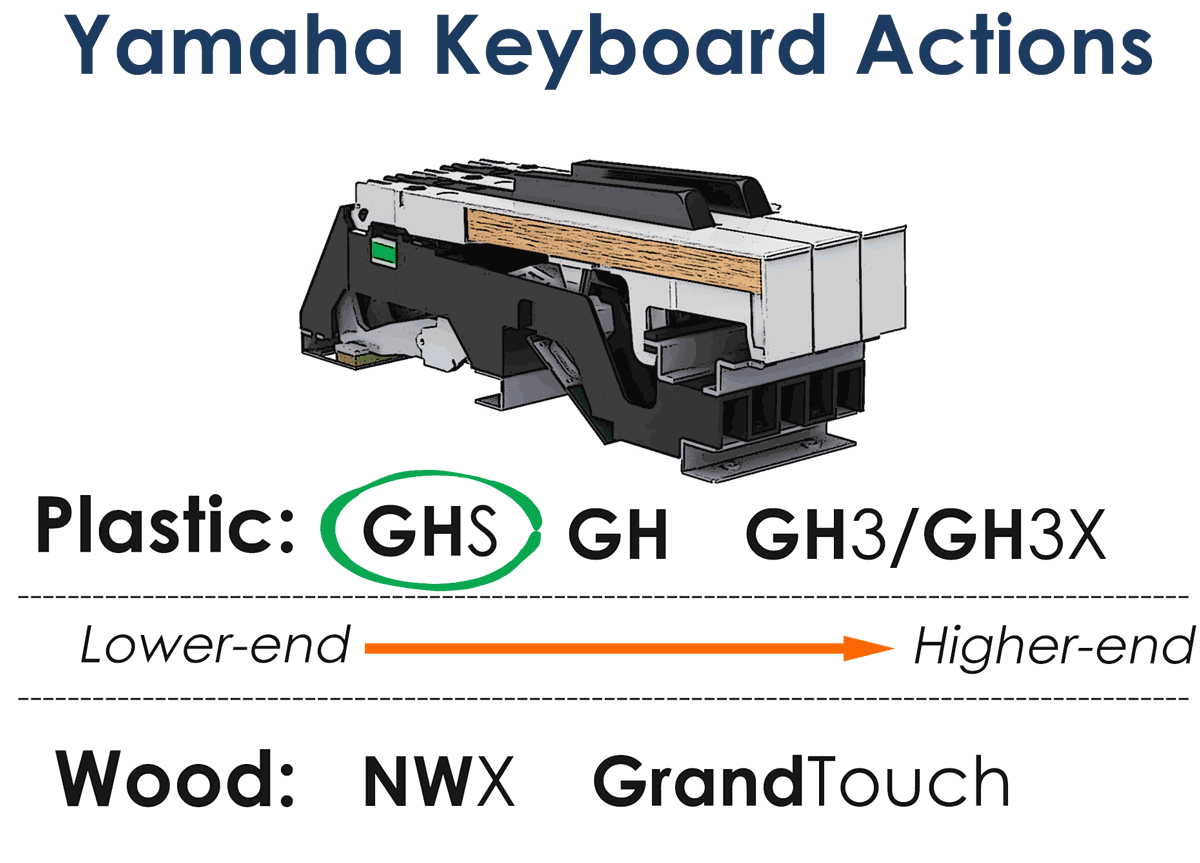
This digital model has two dynamic levels, to recreate all nuances in sound. Its matte black keytops absorb moisture and won’t slip while playing. With Graded Hammer Standard weighted action, and three damper pedal system, it provides great control for each note. You can express yourself like never before.
Also, it has several built-in voices, with advanced sampling technology. You can change up the sound while playing, or practice different musical styles. The Yamaha YDP-144 is great value for beginner and intermediate players.
Sound
Yamaha YDP-144 Digital Piano has unbeatable sound capabilities for its price range. It is outfitted with 88 weighted wooden keys, as well as Yamaha’s Virtual Resonance Modeling sound technology. Plus, it has three touch sensitivity levels to further adjust dynamics.
The Metronome, recording facilities, and Bluetooth midi connectivity make it perfect for home practice and small concerts. Additionally, its Full Grand Piano Room effect adds beautiful reverberation to any performance.
Yamaha YDP-144 Digital Piano is an excellent choice for anyone seeking a high quality, yet budget friendly instrument.
Features
The Yamaha YDP-144 boasts 88 full-size keys with Graded Hammer Standard action – giving you a true acoustic piano experience, where the lower notes will feel heavier and the higher notes more responsive. The dual 30W amplifiers provide a rich, acoustic-piano-like sound. For customizing your tone further, you can use the six different reverb presets.
This instrument also includes a 3-band equalizer and virtual resonance technology for added depth. The YDP-144 features a metronome and piano fingering guide for practice support. Plus, it has two headphone jacks and USB ports for recording or device connectivity. As an extra, you can record songs up to 4 tracks (2 x stereo). This allows you to playback and edit your music on computers.
Pros and Cons
The Yamaha YDP-144 Digital Piano is great for those seeking an affordable, entry-level instrument. It offers a realistic grand piano sound and action with portability and convenience.
Pros: GHS weighted keyboard with just the right resistance, four built-in speakers for a full dynamic range, a metronome feature and 50 preset songs. 3 unique voices to choose from electric pianos, organs and other instruments.
Cons: No Bluetooth connectivity or audio recording capabilities. No stand included. MIDI only USB connection, means no direct connection to computers or other devices.
4. Casio PX-770
The Casio PX-770 is a great digital piano for budget-conscious players. It has an AiR Sound Source engine, allowing it to recreate a nine-foot concert grand piano with impressive sound too. Plus, 128-note polyphony and 18 instrument tones help you experiment with different genres.
The PX-770 is portable and has three built-in headphone jacks. It also has onboard tools, like lesson functions, to teach you how to play. Its Chordana Play app provides tutorials on musical fundamentals, and supervised piano lessons, from qualified instructors.
For its price, the PX-770 offers a lot of features. Its 88 weighted key action system gives an authentic performance. Plus, black walnut panels and carbon fiber keys make it look great. All in all, the PX-770 is an excellent choice for novice musicians who want a reliable digital piano under a thousand dollars.
Keyboard
The Casio PX-770 digital piano is great for pianists of all levels. It features 88 fully weighted keys with an action and feel similar to an acoustic piano. Lower notes require more force than higher notes, adding nuance to your playing. You can customize the instrument’s sensitivity with adjustable touch response.

It has more than 500 built-in sounds, including orchestral instruments and synthesizer presets. It has a SPLIT/LAYER feature, allowing you to mix two sounds at once with independent controls. It has 100 styles of auto-accompaniment, making practice fun and inspiring creativity. It has a USB port for easy connection with computers or portable devices. And all this comes under $1000, making it a great value!
Sound
Casio has worked hard to make their PX-770 digital piano sound great. Its 88-key keyboard has simulated ebony and ivory textured keys, giving you a realistic feel and dynamic accuracy. It also has 18 premium tones and an impressive concert play system with 10 demos. Every time you play it, the PX-770’s sound will be truly realistic. The sound of the piano is a key part of your experience.
Features
The Casio PX-770 is an entry-level digital piano. It’s under $1,000 and packs a lot of features. For better control, it comes with a 3-pedal system. As well as built-in compositions for practice and recitals.
Its Tri Sensor Scaled Hammer Action II keyboard feels authentic. With simulated ebony and ivory textures. Its AiR technology offers great sound quality. From samples recorded from acoustic pianos. The duplex scale feature adds to the sound waves, giving you a vivid tone.

It also has built-in speakers, Bluetooth and USB connectivity. Hall Simulator Reverb settings, additional sounds, and remarkable accuracy when connected to accessories like metronomes and damper pedals. Plus, it has dual headphone jacks, and a color LCD display to adjust settings.
Pros and Cons
The Casio PX-770 is an attractive piano for all skill levels, from amateur to pro. Here are its pros and cons to help you choose.
- Pros:
- 88-key Natural Weighted Hammer Action (NWHA) keyboard gives a feel like an acoustic piano.
- Stylish casing fits most living spaces.
- 18 instrument sounds from grand pianos to organ.
- Simple interface for settings.
- Cons:
- No built-in speakers, need to buy separately.
- No fancy features like recording or advanced MIDI.
[su_button url=”https://digitalkeyboardpiano.com/casio-px-770-review/” target=”blank” style=”stroked” size=”7″ center=”yes” radius=”0″ icon=”icon: thumbs-o-up” text_shadow=”0px 0px 0px #000000″]Full Review[/su_button]
5. Korg LP-380
The Korg LP-380 is an awesome digital piano. It has stereo-sampled piano sounds and 120-note polyphony. Plus, Korg’s RH3 keybed gives you greater control. It has 44.1kHz sampling frequency and 24-bit A/D conversion, so the sound is crisp and clear!
You can connect it to a Mac or PC via USB. It also comes with 10 pre-loaded sounds, onboard effects, two 20 watt amplifiers, 3 pedals and 500 accompaniment styles. All of this for under $1000! It’s perfect for both beginners and experienced pianists.
Keyboard
The Korg LP-380 is ideal digital piano, for those seeking value and top-notch performance. It has 88 full-sized, touch-sensitive keys. Plus, it looks great! This model has three pedal inputs. You can attach optional sustain and expression pedals to get a grand piano experience.

It includes 8 high-quality individual sounds, like strings or harpsichord. You can mix up to 4 of them at the same time. Furthermore, the advanced layering function lets you combine 2 sounds and assign them to individual keys or ranges. All this, under $1,000 USD. It’s a great choice, no matter what type of music you play!
Sound
The Korg LP-380 is a digital piano. It features superior sound quality and a full-size design. Plus, it offers Natural Weighted Hammer Action for an authentic playing experience. The Grandstage Sound Engine provides the sounds, including renowned pianos and other instruments. With added resonance effects, your performances become more expressive.
The LP-380 also has two headphone jacks for private practice. Those seeking to advance their playing can do so with this portable digital piano, which retails for under $1000.
Features
Korg LP-380 digital piano brings amazing features at an amazing price. It’s perfect for both beginners and experts. It has added sounds like strings, electric piano, and organs to the standard piano sounds, providing various listening options.
It offers natural acoustic resonance and damper resonance emulations for a realistic feel. The built-in speaker system ensures clarity in all notes. Layer functionality enables two tones to be played together, and up to six sounds when combined with dual keyboard mode.
It has audio recording that can be exported as audio files (WAV/AIFF) via USB memory connection. Reverb is available for creative recordings. The LCD display allows users to change settings quickly. Its slim and lightweight design fits into any living space and is portable.
Pros and Cons
The Korg LP-380 digital piano is a great buy for anyone under $1,000. It offers a modern design and powerful sound engine. Suitable for a variety of music styles, from classical to jazz to rock.
Pros: It boasts an 88-note keyboard with natural weighted hammer action, providing fantastic keyboard with an acoustic piano-like feel. The two built in speakers provide rich sound quality. The App provides free music lessons and interactive features. The built in recorder allows you to record your music sessions.
Cons: Technical sophistication can make it difficult for some users. The user manual can be confusing. And the selection of sounds may not be as rich on more expensive models.
Things You Must Consider Before Buying Any Digital Piano
Dear readers, we present to you a comprehensive list of the best home digital pianos under $1000, curated based on our expert opinions.
However, if you have not yet found the instrument that meets your specific requirements, we would like to offer additional information that may aid in your quest for the perfect piano.
Below are some of the key terms and features that you are likely to come across while searching for your dream digital piano.
[su_tabs style=”wood”][su_tab title=”Keys” disabled=”no” anchor=”” url=”” target=”blank” class=””]
Contemporary acoustic pianos are equipped with a standard of 88 keys. On the other hand, various other digital pianos and keyboards come in a range of key counts including 88, 76, 73, or 61 keys.
While 73 keys may be sufficient for playing the majority of modern compositions, approximately 99% of them, certain intricate classical pieces necessitate a complete set of 88 keys. Therefore, for those who aspire to play these more demanding pieces, an 88-key keyboard or digital piano is recommended.
[/su_tab] [su_tab title=”Action Types” disabled=”no” anchor=”” url=”” target=”blank” class=””]
There are three primary types of keyboard actions available for digital pianos, synthesizers, and portable keyboards:
1. Non-weighted action is the most common type found in organs, synthesizers, and entry-level keyboards. As the name suggests, it has no added weight or resistance to the keys.
2. Semi-weighted action is a more affordable option commonly found in portable keyboards that cost less than $300. This type of action utilizes a spring-loaded mechanism to provide additional resistance to the keys, giving them a slightly more realistic feel than non-weighted actions.
3. Fully weighted action, also known as hammer action, is designed to replicate the mechanics of an acoustic piano. Instead of springs, it employs small hammers attached to each key to mimic the mechanical movements inside a real piano. A keyboard with fully weighted hammer action keys is highly recommended if you want to play the piano.

Hammer action keys provide a similar feel to that of an acoustic piano, which is essential for developing proper finger strength and technique. This will make it easier to transition to an acoustic piano in the future, should you decide to do so.
[/su_tab] [su_tab title=”Touch Sensitivity” disabled=”no” anchor=”” url=”” target=”blank” class=””]
The touch sensitivity feature, also known as velocity sensitivity or touch response, is a crucial aspect of any keyboard or digital piano. It allows the instrument to produce varying volumes of sound based on how hard or soft the keys are played.
Fortunately, touch-sensitive keys are now widely available in most keyboards and digital pianos, costing over $150 regardless of their action type. Thus, it is no longer a significant concern when choosing a keyboard or digital piano.
What’s more important is whether the keyboard has weighted keys or not. Keyboards with fully weighted action often offer adjustable touch sensitivity, allowing you to customize it to your playing style.
[/su_tab] [su_tab title=”Polyphony” disabled=”no” anchor=”” url=”” target=”blank” class=””]
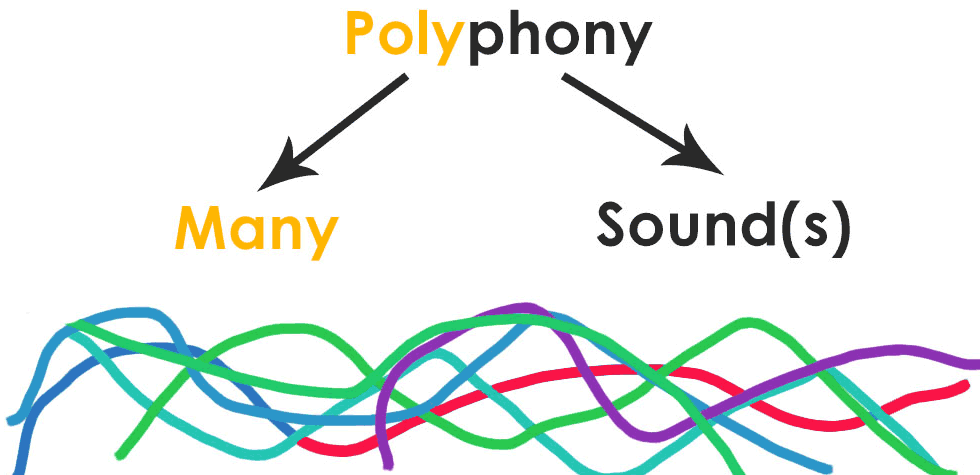
Polyphony refers to the number of notes a digital piano can produce simultaneously. Nowadays, most digital pianos offer 64, 128, 192, or 256-note polyphony.
You may wonder how a digital piano can produce 32, 64, or even 128 notes at once, given that there are only 88 keys, and we never play them all simultaneously. The reason is that many modern digital pianos use stereo samples, which require two notes for each key played.
Moreover, using the sustain pedal, sound effects (such as Reverb and Chorus), dual-mode layering, and even the metronome ticking sound can consume additional notes of polyphony.
For example, when you use the sustain pedal, the earliest played notes continue to sound while you add new ones, and the piano requires more memory to keep all the notes sounding. Another example is when you play along with a song playback or auto-accompaniment. In such cases, the piano needs polyphony for the notes you’re playing and the backing track.
When you reach the polyphony limit, the piano begins to drop the earliest played notes to free up memory for new notes, which can affect the quality and fullness of the sound. Although you’ll rarely need all 192 or 256 voices of polyphony at once, it is possible to reach 64 or even 128 note limits, particularly if you like to layer several sounds and create multi-track recordings.
For an intermediate player, it’s desirable to have 128 notes of polyphony or more.
[/su_tab] [su_tab title=”Modes” disabled=”no” anchor=”” url=”” target=”blank” class=””]
Digital pianos offer more than just the standard “Single” keyboard mode. Additional modes allow you to use two different instrument sounds or even play four-handed simultaneously. Let’s take a look at the most popular modes available on digital pianos:
Split Mode – This mode divides the keyboard into two parts, enabling you to play a different instrument sound in each section. For instance, you could play guitar with your left hand while playing the piano with your right hand simultaneously.

Dual Mode (Layering) – Dual mode lets you layer two distinct sounds to play simultaneously whenever you press a key. You could, for example, layer strings with a piano sound, or any other combination of sounds you fancy, to create new and interesting combinations.

Duo Mode (also known as Duet Play, Partner Mode, Twin Piano) – This mode divides the keyboard into two halves with identical pitch ranges, allowing two individuals to play the same notes simultaneously, including the same middle C notes.
Duet Play is particularly advantageous when used with a teacher or tutor. They can play melodies on one side of the keyboard while you play the same notes simultaneously on the other. It is a fantastic way to learn and develop your piano-playing skills.

[/su_tab] [su_tab title=”Lesson Function” disabled=”no” anchor=”” url=”” target=”blank” class=””]
Certain digital pianos feature a useful function that enables you to mute a song’s left- or right-hand part (track). This allows you to practice playing along to the remaining track that is still audible, either a preset song or one you have downloaded from the internet.
Pianos that have this function typically come equipped with a multi-track MIDI recorder. This tool records each part of a song separately, allowing you to selectively mute or solo specific parts when playing back the song. This feature is an excellent practice tool for honing your skills and improving your ability to play alongside a pre-recorded track.
[/su_tab] [su_tab title=”MIDI Recorder” disabled=”no” anchor=”” url=”” target=”blank” class=””]
A MIDI recorder is a handy tool that enables you to record and playback your own performances without requiring any additional equipment. You can use it to capture your piano playing and listen back to your recordings later.
Multi-track recording is a particularly useful feature of MIDI recorders that allows you to record multiple musical parts onto separate tracks and play them back together as a single song. This feature lets you experiment with your recordings by turning off some of the recorded tracks.
For example, you could record the right-hand part of a song on track 1, and the left-hand part on track 2 while listening to the playback of the first track. You could also create complex, multi-instrument recordings by recording several instrument parts onto separate tracks and playing them back together afterward.
It is essential to note that MIDI recording is not the recording of the actual sound of the instrument. Instead, it records the MIDI data, which consists of a sequence of notes, their length, velocity, and other parameters.
[/su_tab] [su_tab title=”Audio Recorder” disabled=”no” anchor=”” url=”” target=”blank” class=””]
Many digital pianos come equipped with a built-in audio recorder that allows you to record the actual sound of the instrument using its native samples. Once recorded, the file is typically saved to a flash drive in WAV format (Linear PCM, 16bit, 44.1 kHz, Stereo).
Using this function, you can create high-quality recordings of your playing that you can then share on social media, upload to platforms like SoundCloud, or even burn onto a CD.
Audio recordings offer a higher level of universality than MIDI recordings, as they provide you with a CD-quality audio file that can be played on most modern devices without requiring any additional software or sample libraries (VSTs) to render a MIDI recording to audio.
[/su_tab] [su_tab title=”Accompaniment” disabled=”no” anchor=”” url=”” target=”blank” class=””]
One of the most exciting features of some digital pianos is their accompaniment function, which can greatly enhance your performance by providing full backing accompaniment, including rhythm, bass, and harmony that will follow your playing and make you sound like a full band.
The accompaniment changes depending on the notes you play with your left hand, whether chords or even single notes if you don’t know the full chords. In essence, you can manage your own “band” with your left hand by specifying the chords and playing the main melody with your right hand.
Some instruments offer several accompaniment modes and allow you to specify chords using the full range of the keyboard, giving you even more flexibility and creative control over your performance.
[/su_tab] [su_tab title=”Transpose” disabled=”no” anchor=”” url=”” target=”blank” class=””]
The transpose function is a valuable feature that enables you to modify the keyboard’s pitch in semitone increments. This function is particularly useful when you want to play a piece of music in a different key without learning it in a new key and changing your finger placement.
For example, if you already know how to play a song in F major, you can transpose it to C major without learning it in the new key. Additionally, you can transpose a song written in a difficult key, such as one with many black keys, into an easier key with simpler chords while still hearing it in the original key.
The tuning function, on the other hand, allows you to fine-tune the keyboard’s pitch in increments of 0.1Hz or 0.2Hz from the standard A440 tuning. This function comes in handy when you need to match the piano’s pitch precisely to that of another instrument or recording, including an old piano.
[/su_tab] [su_tab title=”USB Type A” disabled=”no” anchor=”” url=”” target=”blank” class=””]
This particular port, also known as the USB to Device port or USB drive port, serves as a convenient tool for connecting a flash drive to the piano for quick and easy file exchange.
For instance, you can transfer MIDI songs into the piano’s internal memory for playback or rehearsal, provided the piano offers this capability. Alternatively, some piano models allow you to play back WAV and MIDI files directly from the flash drive without loading them into the piano’s internal memory.
Finally, you can store your performances recorded with the instrument onto the flash drive and load them back onto the instrument at your convenience.
[/su_tab] [su_tab title=”USB Type B” disabled=”no” anchor=”” url=”” target=”blank” class=””]
The USB port on your digital piano is commonly known as the USB to Host terminal or USB to Computer port. Its primary purpose is to facilitate the exchange of songs, files, and MIDI data between your piano and a computer or smart device using a special adapter.
By utilizing this port, you can transform your piano into a MIDI controller and gain access to a plethora of music applications like GarageBand, FlowKey, and Playground Sessions. These apps can enhance the functionality of your digital piano and provide you with a more immersive and personalized musical experience.
In addition to the applications above, numerous other programs can help you learn, compose, record, and edit music. Some piano manufacturers even offer free apps designed for their particular piano models. These applications typically provide an intuitive graphical interface that allows you to control all of the settings and functions of your instrument.
[/su_tab][/su_tabs]
Frequently Asked Questions
[toggle title=”Q1: What are the Best Digital Pianos Under $1,000?” state=”close”]
A1: The best digital pianos under $1,000 include the Yamaha P-125, Korg Grandstage 88, and Kawai ES8.[/toggle]
[toggle title=”Q2: What Features Should I Look for in a Digital Piano?” state=”close”]
A2: When looking for a best digital piano around, you should consider features such as the number of keys, sound quality, pedal options, and connectivity.[/toggle]
[toggle title=”Q3: What Are the Advantages of Digital Pianos?” state=”close”]
A3: Digital pianos offer the convenience of portability and the ability to record and store music. They also tend to be more affordable than acoustic pianos.[/toggle]
You Might Also Like:
Best Portable Keyboard Pianos for Under $150
Best Beginner Keyboards Under $300


